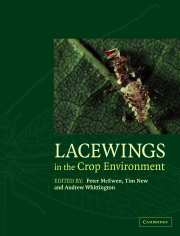Book contents
- Frontmatter
- Contents
- List of contributors
- Preface
- PART 1 Lacewing systematics and ecology
- CHAPTER 1 Introduction to the Neuroptera: what are they and how do they operate?
- CHAPTER 2 Introduction to the systematics and distribution of Coniopterygidae, Hemerobiidae, and Chrysopidae used in pest management
- CHAPTER 3 The common green lacewing (Chrysoperla carnea s. lat.) and the sibling species problem
- CHAPTER 4 Recognition of larval Neuroptera
- CHAPTER 5 Ecology and habitat relationships
- CHAPTER 6 Natural food and feeding habits of lacewings
- CHAPTER 7 Outlines of lacewing development
- PART 2 Lacewings in crops
- PART 3 Principles
- PART 4 Case studies
- PART 5 Conclusion
- Taxonomic index
- General index
CHAPTER 1 - Introduction to the Neuroptera: what are they and how do they operate?
Published online by Cambridge University Press: 04 May 2010
- Frontmatter
- Contents
- List of contributors
- Preface
- PART 1 Lacewing systematics and ecology
- CHAPTER 1 Introduction to the Neuroptera: what are they and how do they operate?
- CHAPTER 2 Introduction to the systematics and distribution of Coniopterygidae, Hemerobiidae, and Chrysopidae used in pest management
- CHAPTER 3 The common green lacewing (Chrysoperla carnea s. lat.) and the sibling species problem
- CHAPTER 4 Recognition of larval Neuroptera
- CHAPTER 5 Ecology and habitat relationships
- CHAPTER 6 Natural food and feeding habits of lacewings
- CHAPTER 7 Outlines of lacewing development
- PART 2 Lacewings in crops
- PART 3 Principles
- PART 4 Case studies
- PART 5 Conclusion
- Taxonomic index
- General index
Summary
INTRODUCTION
Neuroptera (also known as Planipennia), the lacewings, antlions, and their allies, are one of the smaller and more primitive orders of holometabolous insects. About 6000 species are known. They are commonly linked with the Megaloptera (alderflies, dobsonflies) and Raphidioptera (snakeflies) in the superorder Neuropteroidea (or Neuropterida), and are of world-wide occurrence, although many taxa are more restricted and some are characteristic faunal elements of particular regions. Neuroptera have a long evolutionary record, and there are many fossils from the Permian and Jurassic which are referable clearly to this order (Carpenter, 1992), mainly on details of the complex wing venation which gives lacewings their common name. Most are terrestrial, although a few (such as the specialised Sisyridae, the spongeflies, whose larvae are predators of freshwater sponges, and Nevrorthidae) frequent freshwater environments. Adults and larvae of most families are predatory, and the main interest of the order to many entomologists is that which forms the major theme of this book – that some lacewings can be of considerable value as manipulable predators for use in biological control programmes. This brief introduction is a broader survey of the Neuroptera, to facilitate a more general perspective of the order. Thus, whereas this book is about members of only three families (Coniopterygidae, Hemerobiidae, Chrysopidae with the last by far predominant), up to 18 Recent families are recognised, and a number of others are extinct. The phylogenetic relationships between some of these are still debated.
- Type
- Chapter
- Information
- Lacewings in the Crop Environment , pp. 3 - 5Publisher: Cambridge University PressPrint publication year: 2001
- 3
- Cited by



